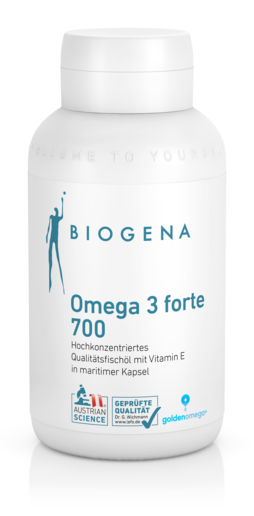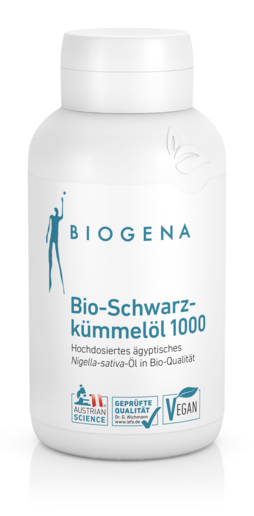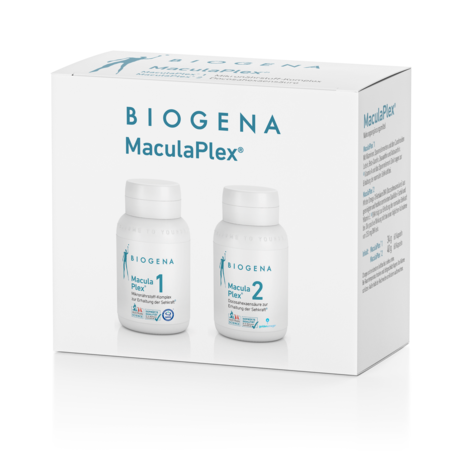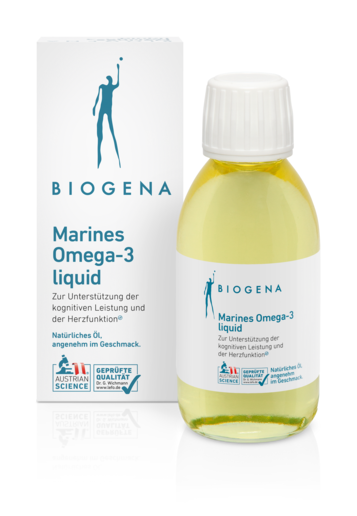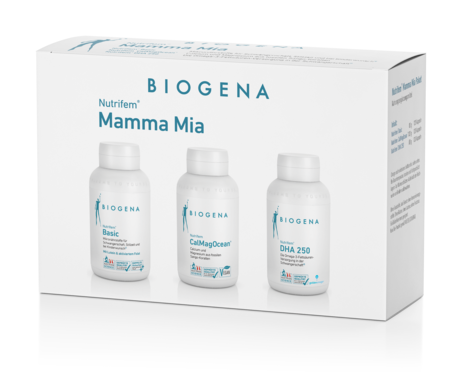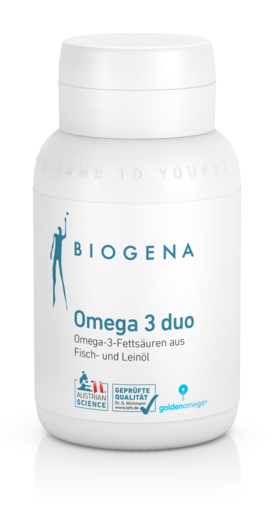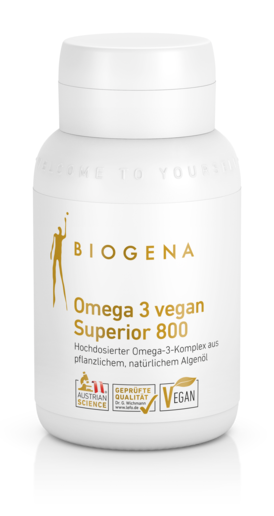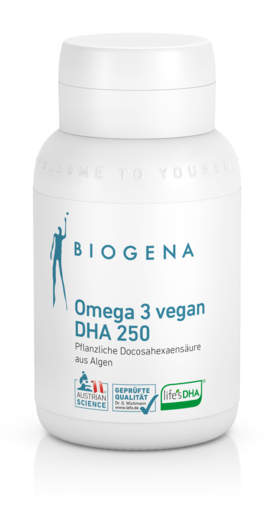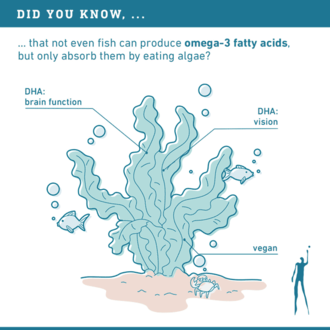Omega-3 fatty acids
Omega-3 fatty acids support important bodily functions. The daily intake of the essential fatty acids DHA and EPA, for example, makes a significant contribution to the maintenance of normal heart function and much more.



Omega-3 fatty acids: as essential as vitamins
The body needs multiple unsaturated fatty acids just as it needs vitamins and minerals. Through long-term observations and scientific studies, we know very precisely how important the adequate absorption of Omega-3 fatty acids is for humans.
What are omega-6 and omega-3 fatty acids?
These belong to the so-called polyunsaturated fatty acids (PUFA). Vitally important for the human body, polyunsaturated fatty acids can be divided into two groups - omega-3 and omega-6 fatty acids - according to their structure. The ratio of the physiological counterparts is also important for our vitality. Ideally, omega-6 fatty acids and omega-3 fatty acids should be present in the diet in a healthy ratio of 2:1, up to a maximum of 5:1. While omega-6 fatty acids can be found in many vegetable oils and animal products such as eggs, milk, and meat, rich amounts of omega-3 fatty acids can only be found in a few select foods. This makes it all the more important to keep a close eye on your omega-3 intake.
Not all fats are created equal. But what makes the various types of fatty acids different? Here's what our science team has to say: Saturated and unsaturated fatty acids - what’s the healthy option?
The general effect of omega-3 fatty acids
Omega-3 fatty acids help keep our bodies in good working order. Not only do they serve as cellular components and act as precursor hormones, but our brains are largely made up of omega-3 fatty acids, especially DHA. This makes these fats particularly important for fetal development; a good maternal supply of omega-3 supports the healthy development of a baby’s brain and eyes. But omega-3 fatty acids are also excellent nutritional partners for adults. A good supply of EPA and DHA supports the function of the heart and the maintenance of normal blood pressure and blood lipid levels. Not only that, omega-3 fatty acids help us not to lose focus: 250mg DHA daily can contribute to vision maintenance.
The heart and omega-3 fatty acids
Supplying oxygen and nutrients to all the other organs in the body, it’s safe to say that the heart plays a central role. It acts as a positive displacement pump, using a valve-controlled system to move blood through the body, drawing it from the veins and propelling it through the arteries. This is how nutrients get to where they are needed. A person simply cannot live without a heart.
It is not for nothing that we speak of matters of the heart, the heart’s desire or use heart symbols to express affection. Those who are lovesick often speak of "heartache" or “heartbreak” and when something involves special care and devotion, it is done with "a lot of heart".
You can support the proper function of this central powerhouse of life with the right diet.
- The omega-3 fatty acids DHA and EPA support the function of the heart (0.25g/day).
- DHA and EPA contribute to the maintenance of normal blood pressure (3g/day).
- DHA and EPA contribute to the maintenance of normal blood lipid levels. (Cholesterol levels are also related to this.)
Omega-3 fatty acids and vision
Working on computers, artificial lighting, long working hours, and screen-based media consumption: we put our eyes through a lot of daily strain. But there are things we can do to help protect our important sensory organs: as well as eye exercises, regular breaks from screens and suitable sun protection, a daily intake of 250mg of DHA has a positive effect on the eyes, helping to preserve our vision.
Omega-3 fatty acids during pregnancy, breastfeeding, and growth
During pregnancy and breastfeeding, there is an increased need for DHA. Many gynecologists recommend an additional intake of omega-3 fatty acids during this time. Sufficient supplementation of the mother during pregnancy and breastfeeding correlates positively with the development of the child's vision and brain.
Since some women develop an aversion to certain foods or smells during pregnancy, many turn to food supplements. There is an increased need for different micronutrients throughout the different phases of pregnancy. Ideally, the supplement products taken should be combined in such a way as to best support the supply and growth.
DHA – Docosahexaenoic acid | EPA – Eicosapentaenoic acid |
| The main effect of DHA is an increase in the fluidity and permeability of the membranes. | The omega-3 fatty acid EPA has properties which influence the formation of anti-inflammatory substances. |
Occurrence in food
In food, DHA and EPA are found in abundance in fatty cold-water fish, such as salmon, tuna, herring, mackerel, and sardines.
These accumulate omega-3 fatty acids in the form of EPA, DHA, and ALA in their cell membranes and fatty tissues by eating special microalgae and microcrustaceans. Due to the high omega-3 content, the cellular membranes of the animals remain flexible at low temperatures. Certain microalgae such as Ulkenia or Schizochytrium are a plant source of DHA and EPA. In enriched form, as algae oil capsules, they are a plant-based alternative for vegetarians, vegans, and people with an aversion to fish.
Omega-3 fatty acids and a vegan diet: Are they compatible?
In most cases, highly-concentrated DHA is obtained from fish. However, fish do not produce the omega-3 fatty acids themselves, any more than we do - they absorb them by eating algae.
Certain microalgae contain valuable DHA, making them a vegan alternative to conventional sources of these popular omega-3 fatty acids. Fish accumulate DHA in their natural environment through the consumption of marine algae. For this reason, cultivating these algae is a sensible and also more sustainable way to ensure a supply of this important omega-3 fatty acid. This provides vegetarians and vegans with a suitable alternative that fits into their diet plan.
Sources of vegan omega-3 fatty acids at a glance:
Algae, such as Schizochytrium sp.
Vegetable oils, such as linseed oil, hemp oil, walnut oil, camelina oil
The difference between vegetable and marine (fish-derived) oil
While marine oils (e.g. from fatty fish and algae) provide us with physiologically important DHA and EPA, selected vegetable oils (e.g. linseed oil) provide vegetable omega 3 in the form of ALA (alpha-linolenic acid). ALA can be converted by our bodies into EPA and DHA, but the conversion rate varies from individual to individual and is also subject to certain influencing factors such as age and gender. For example, studies have shown that men are less able to convert ALA into DHA than women (4% vs. 9%).
Conclusion: Plant-based omega 3 from linseed oil and similar is undoubtedly a very valuable addition; however, the individual omega-3 status should also be kept in mind (ideally via a measurement of the omega-3 index) and, if necessary, the use of an EPA/DHA rich algae oil or fish oil supplement should be considered.

Omega-3 fatty acids – how much is enough?
Omega-3 fatty acids - in contrast to saturated fatty acids - cannot be produced by our bodies. Therefore, we depend on gaining a sufficient supply from external sources, i.e. through our diet. Experts assume that the need for EPA and DHA is between 100 and 200mg (minimum intake) or between 300 and 400mg (desirable intake). Under certain circumstances (e.g. pregnancy, breastfeeding), even higher amounts of these essential fats may be recommended.
NEW SCIENTIFIC FINDINGS
Recent studies confirm that omega-3 intake is deficient
Not all fats are created equal. The quality, composition, and ratio of the fatty acids we consume make all the difference. But it is specifically DHA, EPA, and the omega-3 variant ALA, which is found in certain vegetable oils, that are often lacking in our diet.
Omega-3: Practical application tips
When should omega 3 be taken?
Omega-3 fatty acids should be taken either with a main meal or snack, ideally something with a high-fat content to optimize the absorption of omega-3 fatty acids. According to current understanding, the time of day does not make a difference and can be chosen according to preference.
Omega-3 oil: What if you can’t swallow capsules?
Some people wish to supplement their diets with additional omega-3 fatty acids but are unable or unwilling to swallow the large fish oil capsules. There are many reasons why people may be reluctant to swallow capsules. However, this is not the only way to achieve a healthy supply of essential omega-3 fatty acids. Another way to supply the body with DHA and EPA is a liquid omega 3.
The premium fish oil boasts a pleasant lemony flavor, which makes it particularly good for people who dislike the taste of fish. The oil is very easy to dose with a spoon and can be taken pure or used on salads, vegetables, or other dishes.



